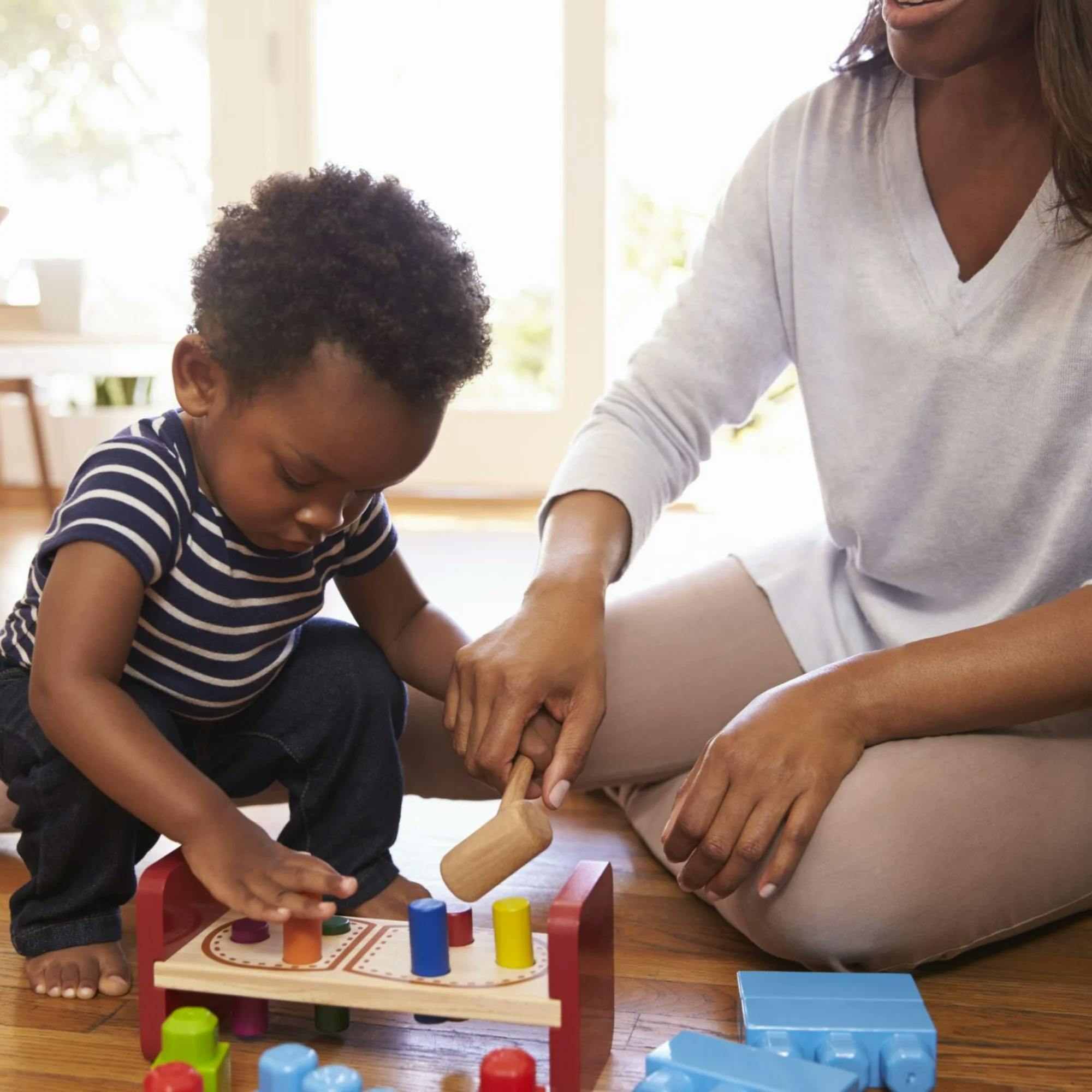If you’re considering speech therapy for your toddler, or they’re about to begin sessions, you likely have some questions. A big one is probably, “What does a toddler do in speech therapy?” That’s why we’ve put together this guide to speech therapy for toddlers. Let’s take a look at what you can expect.
Find the right speech therapist for your child
We'll match you with a licensed speech therapist who's experienced in your child's needs and available when you are.
 Get started
Get startedSpeech and language evaluations for toddlers
Your child’s first speech therapy session will be a speech and language evaluation. The speech therapist will get to know you and your child. They’ll ask you questions and watch how your child interacts with you and plays. The goal is to get a full picture of how your child is currently communicating.
The speech therapist will then do testing to look at skills such as:
What words your child can understand
What sounds, words, and sentences they can say
How they pronounce their speech sounds
After the evaluation, the speech therapist will assess the results and write up a report. The report will explain the test outcomes, whether therapy is recommended, how often sessions should take place, and the goals to target in therapy.
These goals are a big piece of the evaluation. Your speech therapist has the training to determine which goals will help your child get where they need to be. For example, if your child isn’t talking yet, the speech therapist may write a goal for helping your child imitate words. After they meet that goal, the therapist may write a goal for producing spontaneous words, and so on. All the activities during your child's speech therapy sessions connect back to these goals.


How does speech therapy work for toddlers?
You may be wondering, “How will you get my child to pay attention during speech therapy?” Easy–through fun and games!
Toddlers aren't known for sitting still. But the great thing about speech therapy for toddlers is that their goals can be targeted through play. It may look like the speech therapist is “just playing” with your child, but there’s a lot more happening beneath the surface than you might realize.
Inside the session: Watch a toddler having fun with online speech therapy!
Watch hereThe fact is, toddlers learn language skills through play-based activities. While we often think of play as taking a break from work, it’s quite the opposite for kids. Play is how children learn and explore the world around them. This is why developing good play skills is so beneficial to their language growth and development.
Your therapist will find ways to “hide” speech therapy tasks in a play activity. For example, say your child is practicing the /m/ sound. A puzzle is a great toy to use in practicing this sound. The speech therapist may have the child imitate “mmmmm” while modeling the word “more,” to have the child request more pieces of their puzzle. Check out this quick video for a look at how a speech therapist might use a puzzle in sessions.
Practicing speech therapy activities at home
If you’re doing online speech therapy, the idea isn’t for your child to sit still and pay attention to a screen for 30 minutes. Your speech therapist will likely use the parent coaching model, teaching you how to interact and play with your child during sessions. This way, you can keep practicing throughout the week–which will lead to faster progress for your little one. Here are some examples of play activities used in therapy that families can practice at home:
Offering a choice of two toys and having your child pick
Waiting to take a turn until your child says “go”
Rolling a ball back and forth to mimic a conversational exchange
Using toys for their intended purpose, like making food with a toy kitchen or speaking on a pretend phone
Using identification questions, like “Where is the dog?” or “Show me the red block”
Saying words to see if your child will imitate you, which is called modeling
What makes the parent coaching method of speech therapy so rewarding is that you are eliciting language from your child, not the speech therapist. The speech therapist is there to introduce new ideas, teach techniques, and provide support throughout the sessions.
Help your child’s new speech and language skills “stick”
Here’s a question to ask yourself: If your child is receiving speech therapy for 30 or 60 minutes a week, what happens the rest of the week? Let’s face it: The time you have with your speech therapist is limited, whether it’s online or in person. The important work happens outside of therapy sessions. Toddlers don’t learn language from flashcards, or worksheets, or fancy materials. They learn and absorb language from the people they love and interact with most in their life: you.
When you practice speech and language with your child at home, it helps their new skills “stick.”
That’s why it’s crucial for families to practice and carry over speech therapy techniques between sessions, during everyday life. When you practice speech and language with your child at home, it helps their new skills “stick.” For example, your child may be able to demonstrate a new skill during therapy, but they also need to be able to “generalize,” or use these skills in their daily life. After all, that’s the entire point of therapy!
When you know how to practice and reinforce these skills at home, your child will make faster progress. And best of all, this can happen during one of your toddler’s favorite activities–playing with you.


How to prepare for your toddler’s first speech therapy session
There are a few things you can do to hit the ground running in speech therapy. First, spend some time thinking about or writing down any concerns about your child’s development. You can also think about any goals you have for your child. Discuss all of this with your speech therapist, and ask if these goals can be targeted in treatment.
It’s not always easy to remember the exact age when your child reached certain milestones. But during the evaluation, your speech therapist will likely ask about skills like crawling, walking, first words or attempts at communication, and more. So pull out the old baby book and take a look!
If you’re doing online speech therapy, keep some of your child’s preferred toys nearby for the session. Your speech therapist will want to use things like books and toys to help prompt communication from your child. You can also let your speech therapist know what kinds of games, activities, and characters your child enjoys.
And remember–your questions are always welcome! The speech therapist is there to help your child, but they’re also there to support you. Ask your speech therapist about the best way to communicate with them between sessions. You should be able to contact your therapist with updates and questions during the week, so they can plan for the next session–and you get the guidance you need to help your child’s communication soar.
How Expressable Can Help
Concerned your child isn't reaching age-expected milestones? Looking for communication support from a professional? Expressable is a national online speech therapy practice serving children and adults. We treat all major areas of communication and feeding, offer flexible hours including evenings and weekends, and accept most major health insurance plans. We’re proud to have earned more than 3,000 5-star reviews from our clients (4.9/5 average).
Our therapy model is centered on parent and caregiver involvement. Research proves that empowering caregivers to participate in their loved one’s therapy leads to better outcomes. That’s why we combine live, 1-on-1 speech therapy with personalized education and home practice activities for faster progress.
Communication is more than words. It’s how we share how we feel and show who we are. We’re here to help you or your child do just that.

 Abby Barnes, M.S., CCC-SLP
Abby Barnes, M.S., CCC-SLP













